Reviewer's Note: The P20C2 and P20A2 were provided for review by EagleTac. Please see their website for more info.
UPDATE APRIL 21, 2010: EagleTac has come out with new Mark II versions of these lights. Please see my more recent review for details.
Warning: Even more pic heavy than usual!
Manufacturer's specifications, condensed from EagleTac's website:
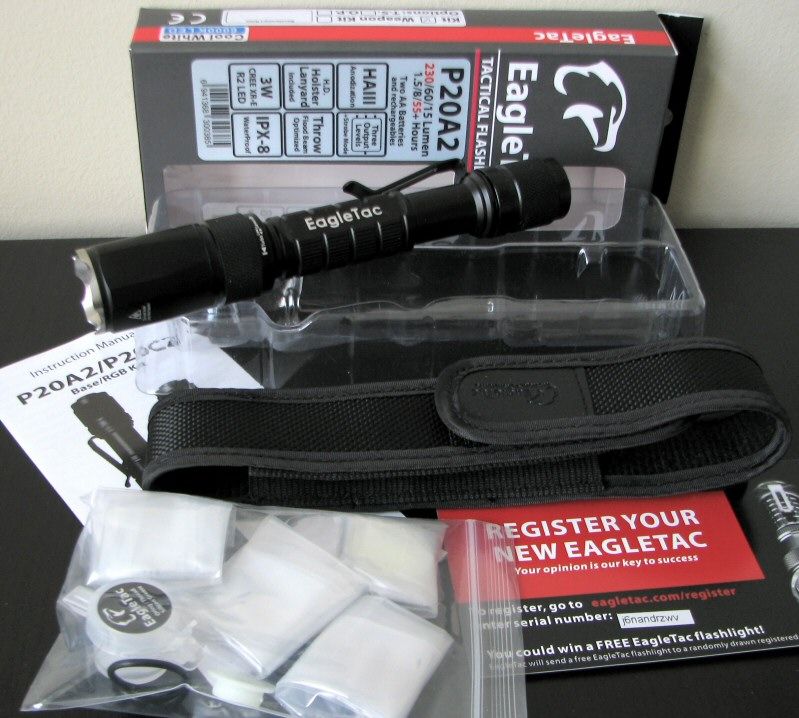
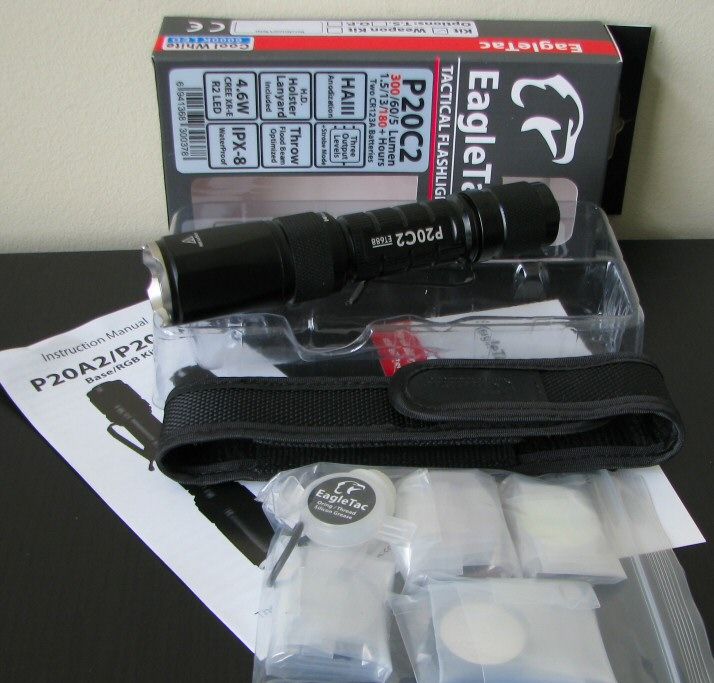
By default, each P20A2/C2 comes with a manual, warranty card, spare o-rings, o-ring lube, extra GITD tailcap boot cover, good quality belt pouch with closing flap and lens diffuser attachment. :sweat: Optional accessories are the RGB filter kit (shown above), OP reflector, wrist lanyard and tailstanding tailcap (shown below).

Note that the green and blue filters have a reflective finish, just like the Olight filters. Here they are without and with a flash, to show you how they look:
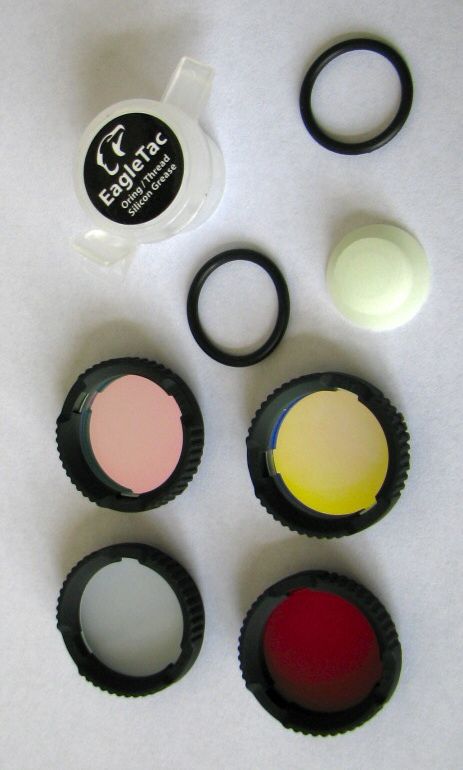
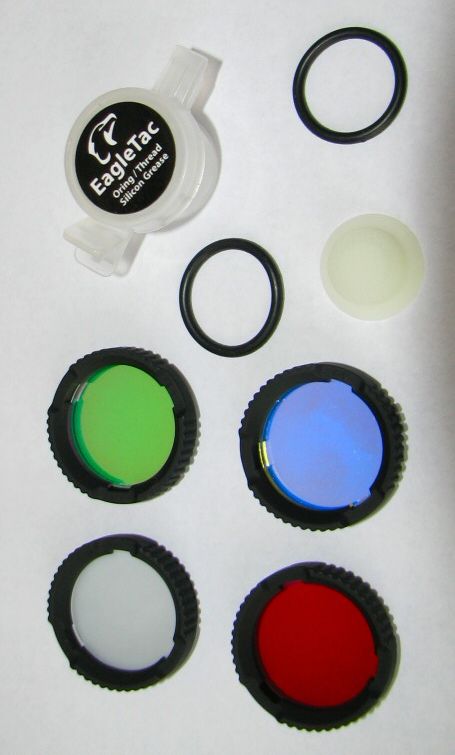
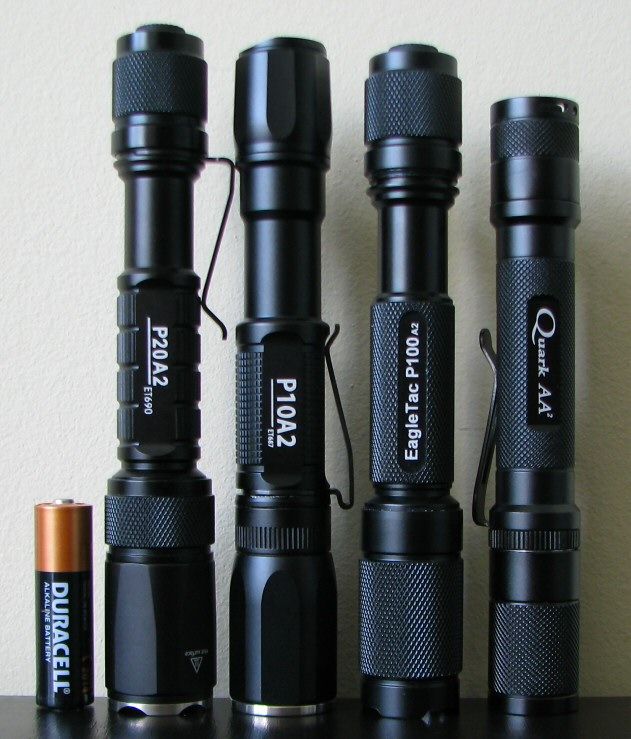
From left to right: Duracell AA battery, EagleTac P20A2, P10A2, P100A2, Quark QAA-2.
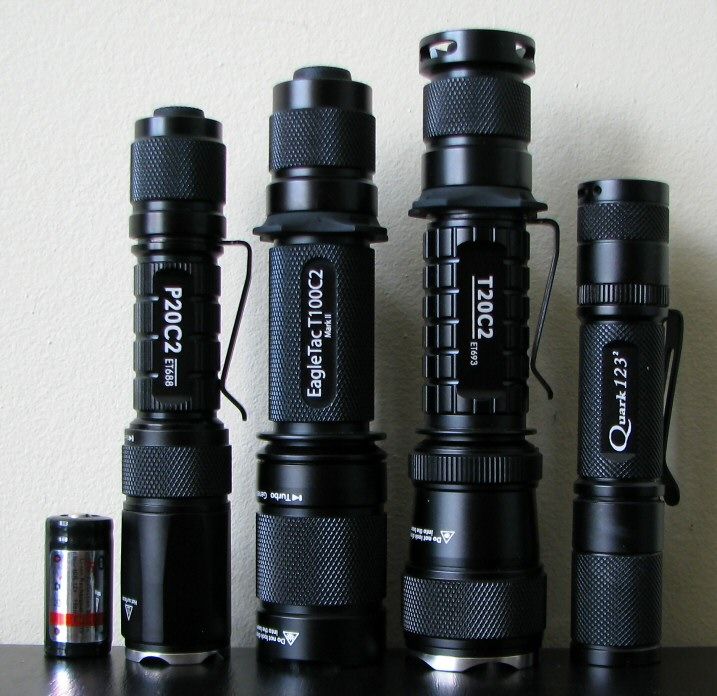
From left to right: AW protected RCR, EagleTac P20C2, T100C2 MII, T20C2; Quark Q123-2.
P20A2: Weight 91.2g, Length 164mm, Width 26.6mm (bezel), 23.1mm (tailcap)
P20C2: Weight 78.8g, Length 133mm, Width 26.6mm (bezel), 23.1mm (tailcap)
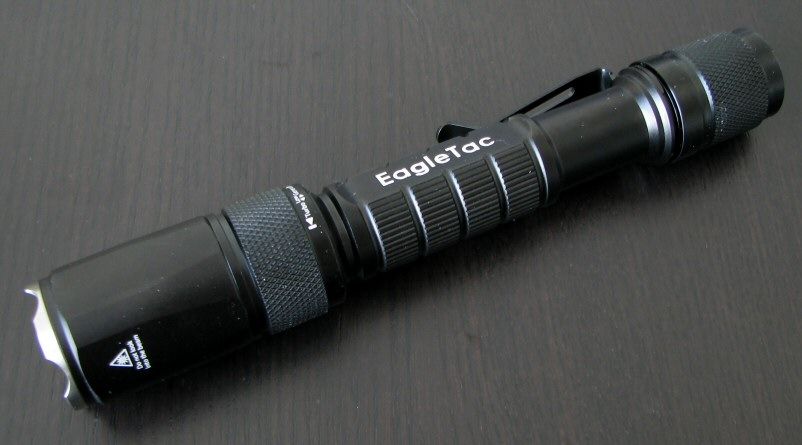
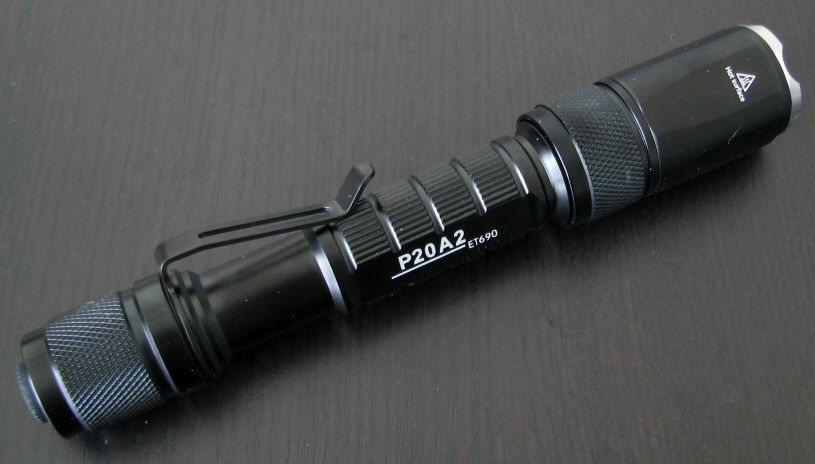
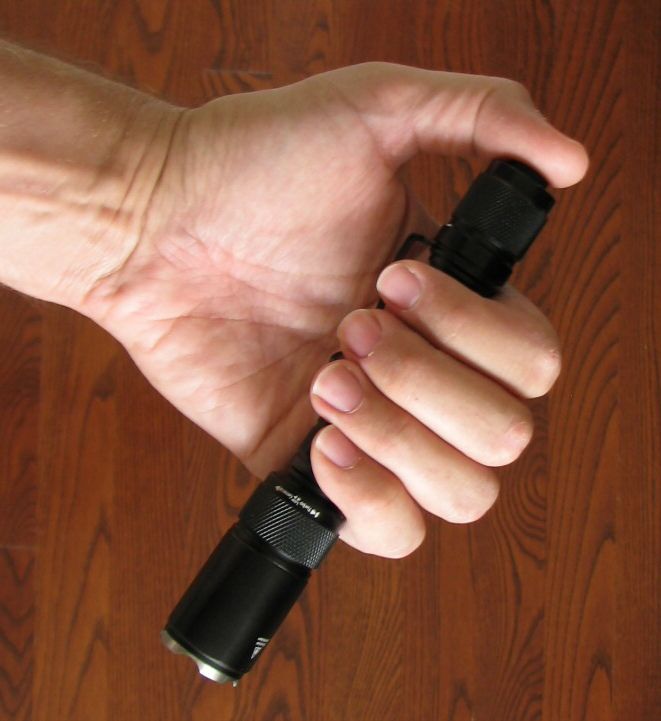
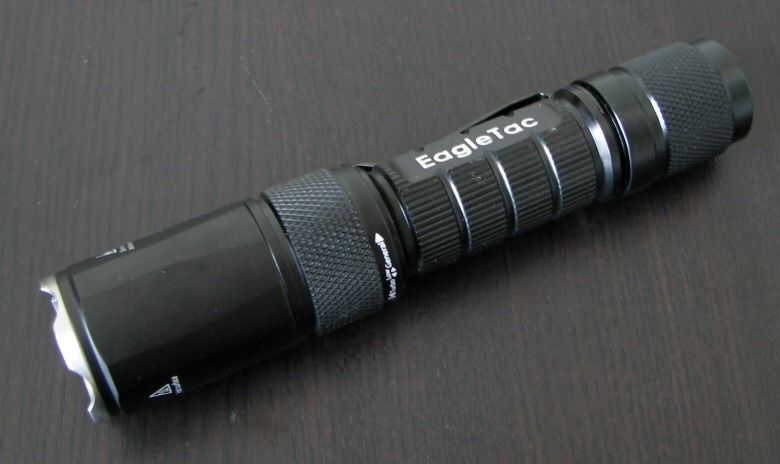
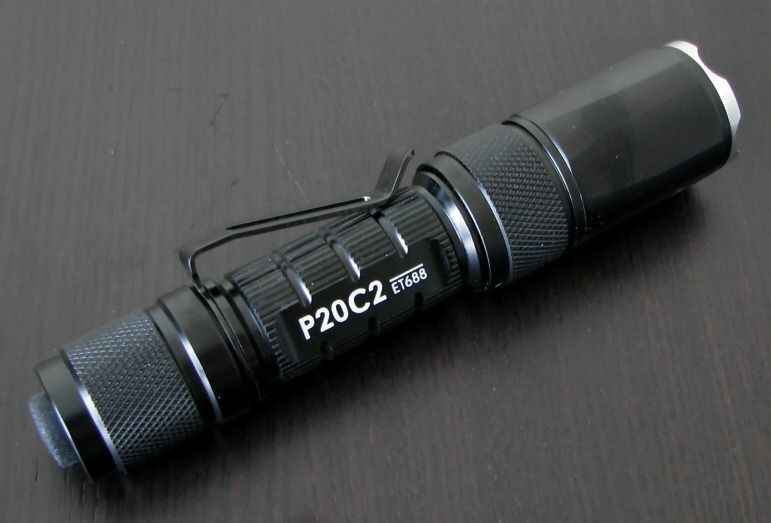
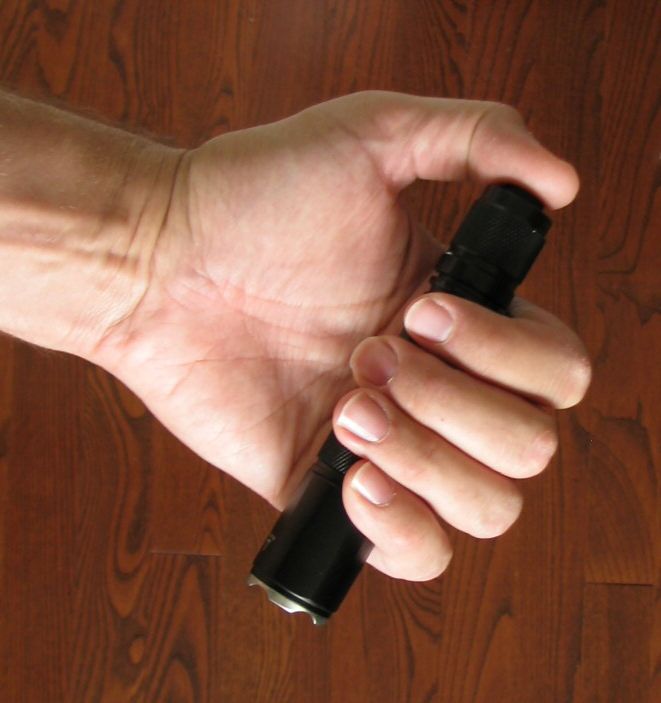
The body tubes are the most obvious change from earlier lights. Consistent with the new T20C2, there are now extra raised areas along the length. Given the lower thickness of these lights, this looks a little cheesy to me – but that's just a personal preference . The heads are reminiscent of the earlier P10A2/C2 era for EagleTac, although there are some changes here (scroll down for more beamshots).
. The heads are reminiscent of the earlier P10A2/C2 era for EagleTac, although there are some changes here (scroll down for more beamshots).
 Note that the body tube of the P20C2 is only wide enough to allow a protected 17670 cell to fit – 18650 is too wide.
Note that the body tube of the P20C2 is only wide enough to allow a protected 17670 cell to fit – 18650 is too wide.
Fit and finish are excellent on my sample, no obvious flaws in the black type-III hard anodizing (although chips in the knurling are not uncommon on EagleTac lights). Consistent with other EagleTac lights, the knurling on the bezel and tailcap is quite aggressive. Identification labels are very sharp and clear, in bright white against the black background.
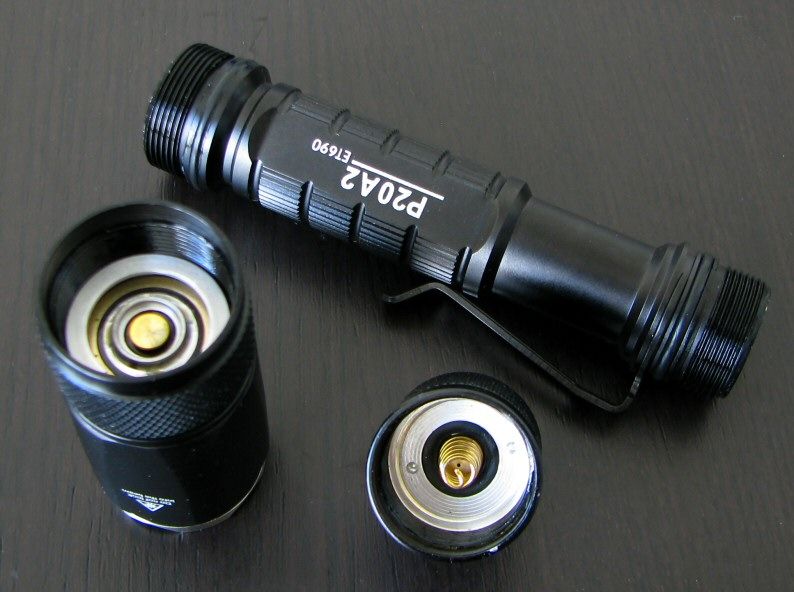
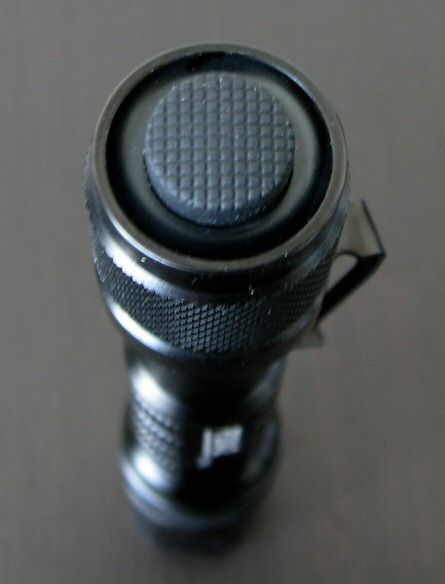
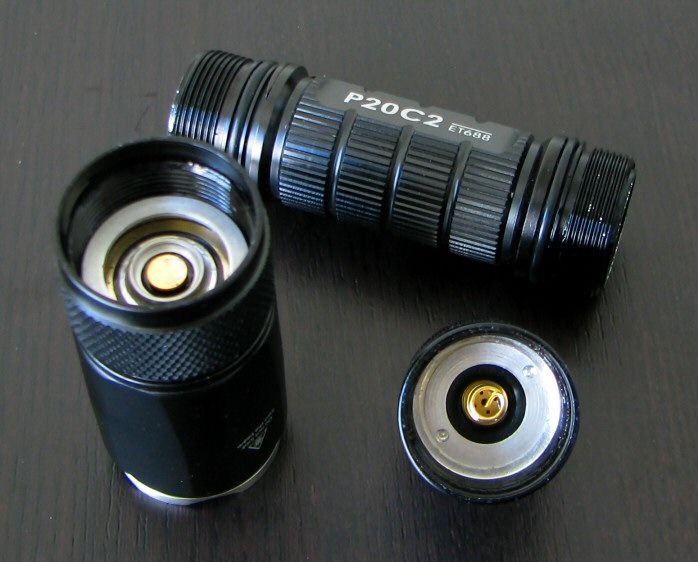
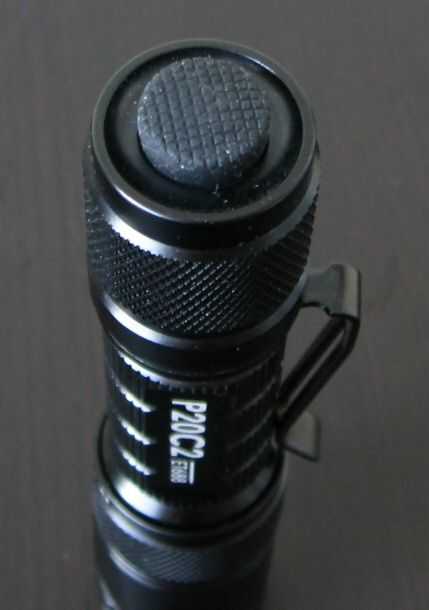
Screw threads are anodized for head or tailcap lock-out. :thumbsup: Due to the standard protruding forward clicky, the light cannot tailstand in its default form – but you can get the tailstanding tailcap accessory (scroll back up for a pic).
Note that the black stainless steel clip is removable, but be careful not to scratch the anodizing when removing/attaching the clip (I find a little teflon oil can help).
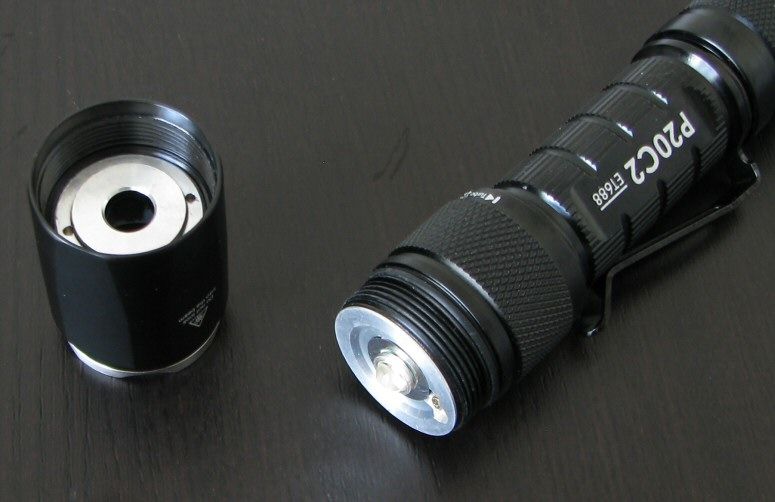
The reflector can be easily swapped after unscrewing the head portion of the light. To allow you to better compare, I've installed the OP reflector in the P20C2 for the shots below.
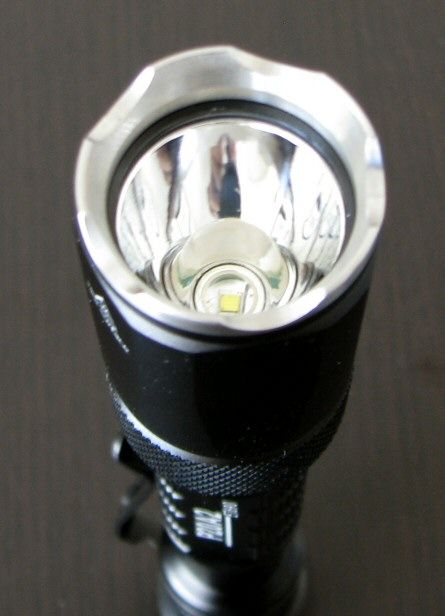
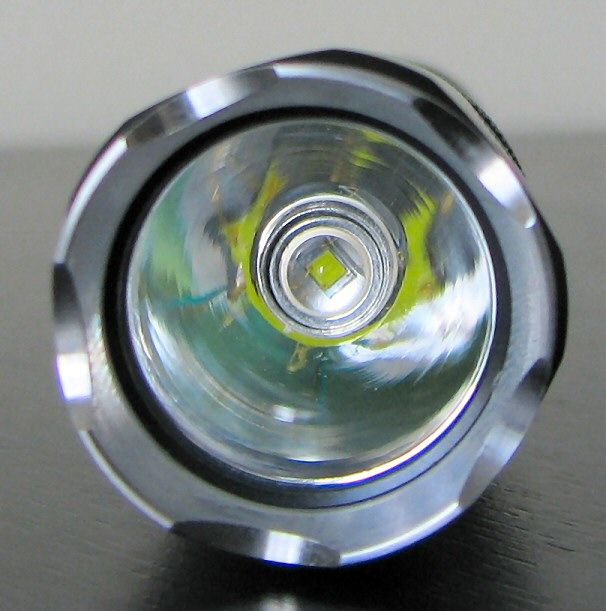
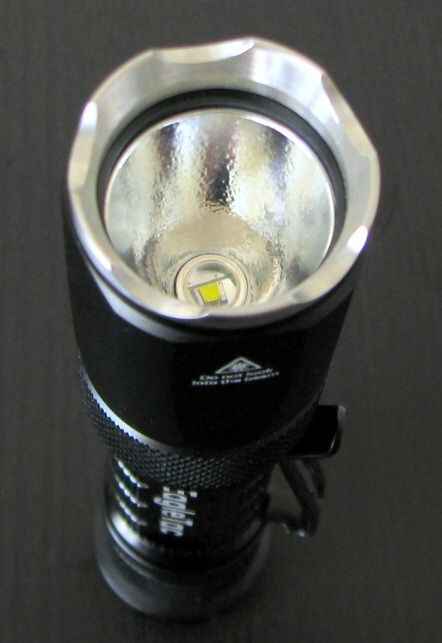
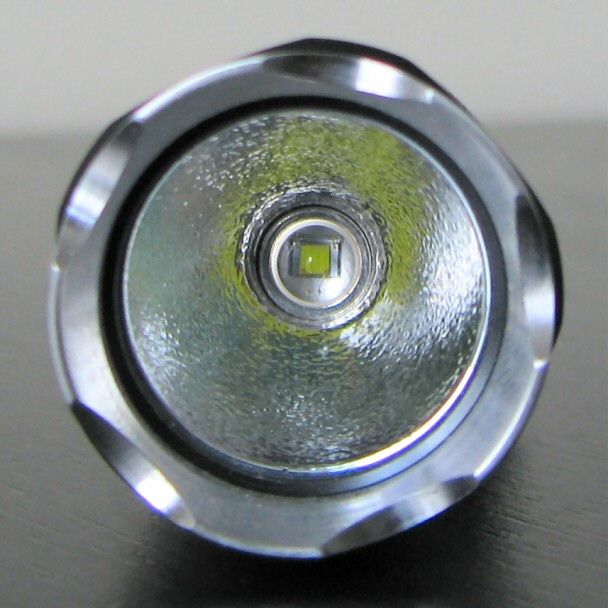
The light uses the standard Cree XR-E emitter, with a R2 output bin in this case (WD tint reported). Also available from EagleTac is the relatively warm "neutral" 5A tint with a Q4 output bin. For those of you not familiar with tint bins, please see my Colour tint comparison and the summary LED tint charts found here.
And now for the requisite white wall shots: all lights are on Max on an Sanyo eneloop (2xAA lights) or AW protected 18650/17670, about 0.5 meters from a white wall.
First, a direct comparison of the P20A2 (with smooth reflector) and P20C2 (with OP reflector):
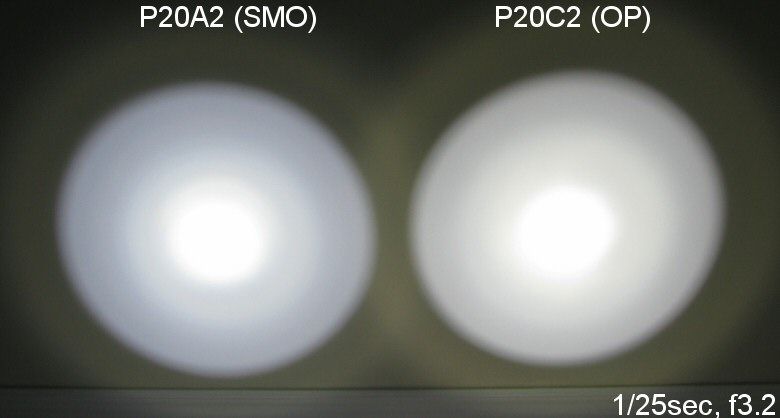
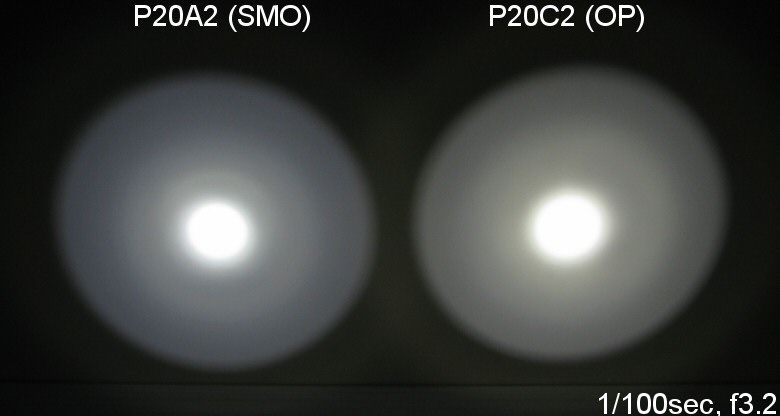
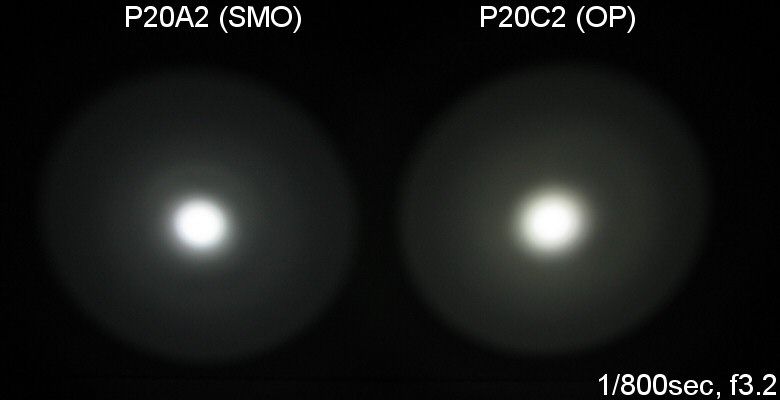
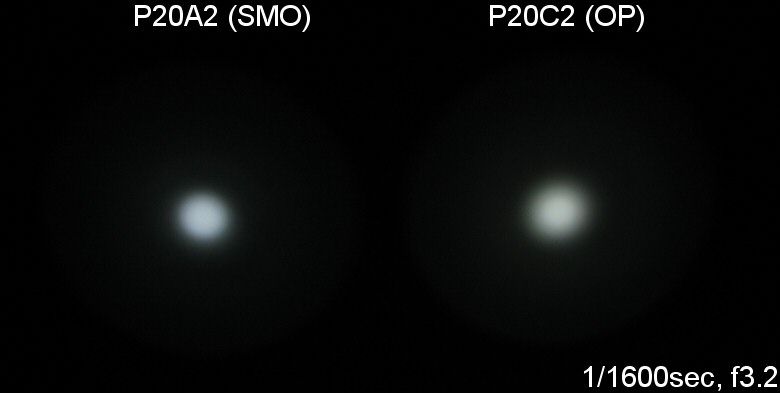
As you can see, there is not a huge difference in terms of the beam profile. I personally prefer the OP reflector, as it helps smooth some of the rings without affecting throw very much (reminds me of the early JetBeam Jet-II/III reflectors - some smoothing, with little loss of throw).
Here's how the lights compare to some of the competition:
P20A2
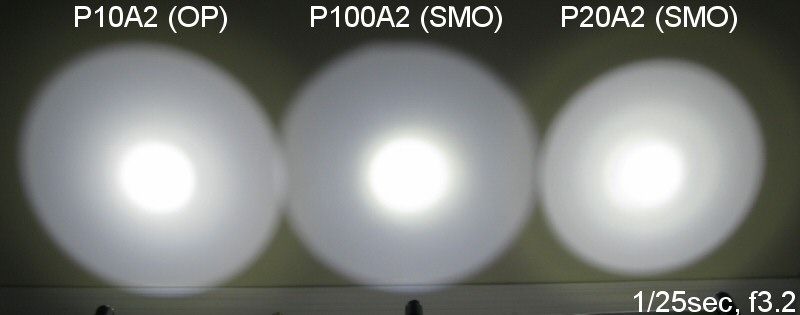
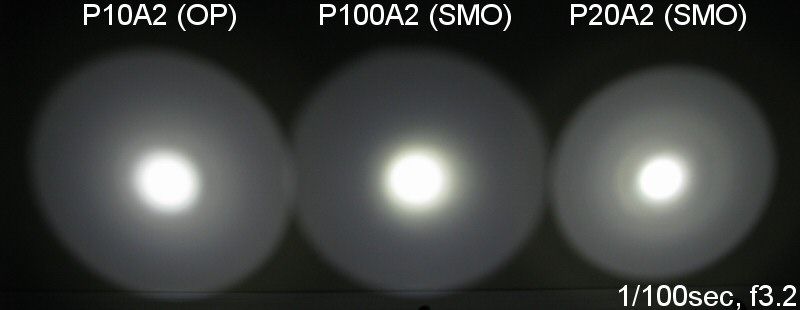
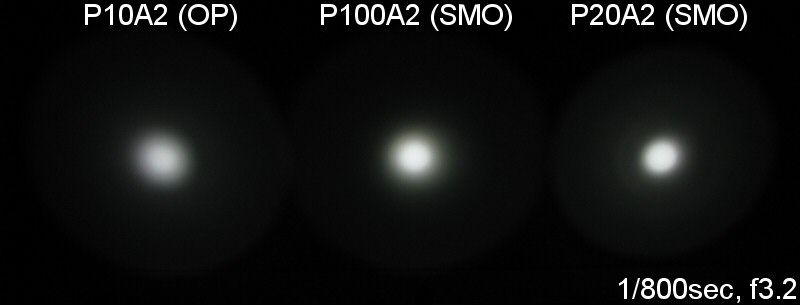
P20C2
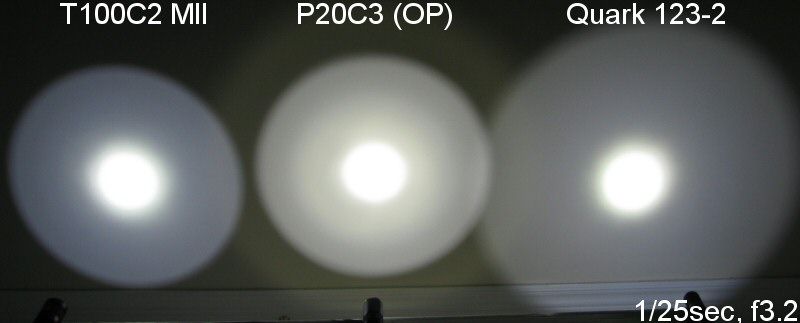
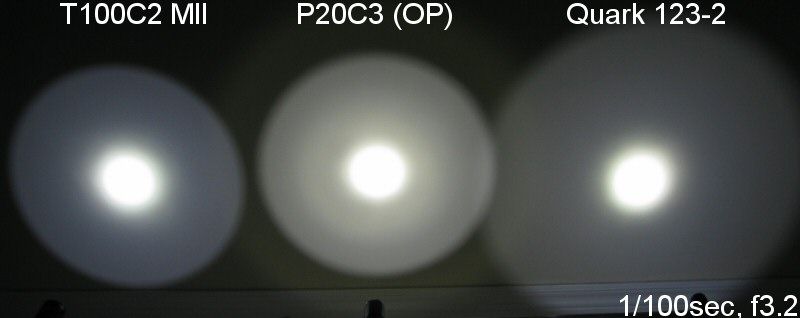
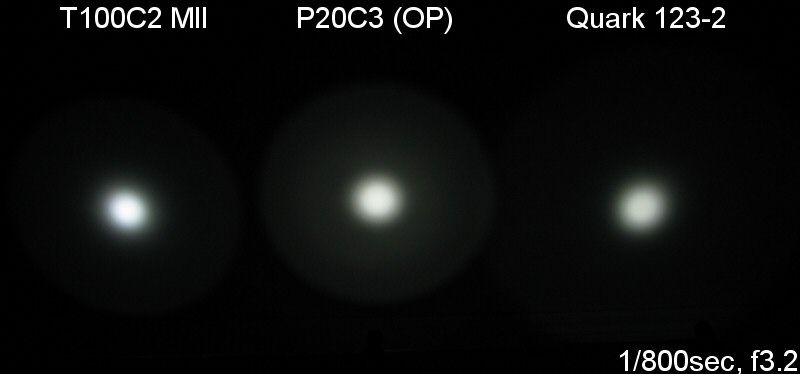
One of the more interesting features of these lights is how you can remove the bezel retaining ring and screw on the included diffuser (or optional RGB filter kit). This is a fairly smart way to attach a filter/diffuser, although you have find a place to stick the bezel ring when not in use. I found mine all screwed on fairly easily (except for the red filer in one case, which was a little stiff). The quality of the included filters and diffuser seem very good – on par with the Olight filter/diffuser material available for a number of their lines.
To help you compare the effects of the diffuser and RGB filters, here are some individual shots taken of the P20C2 with the OP reflector (~1m from the wall, 1/25sec exposure, f3.2).
OP reflector:
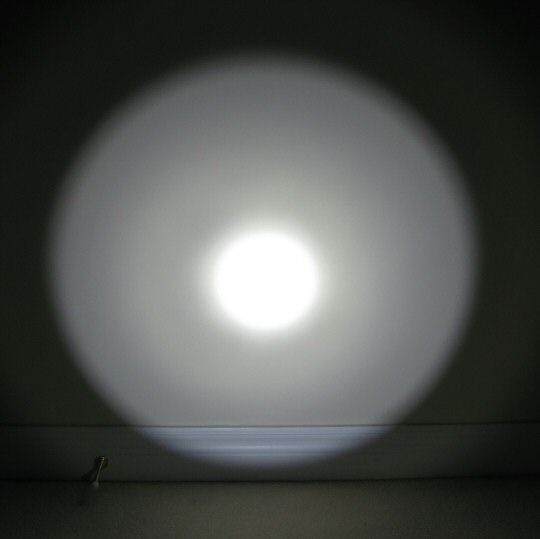
With diffuser:
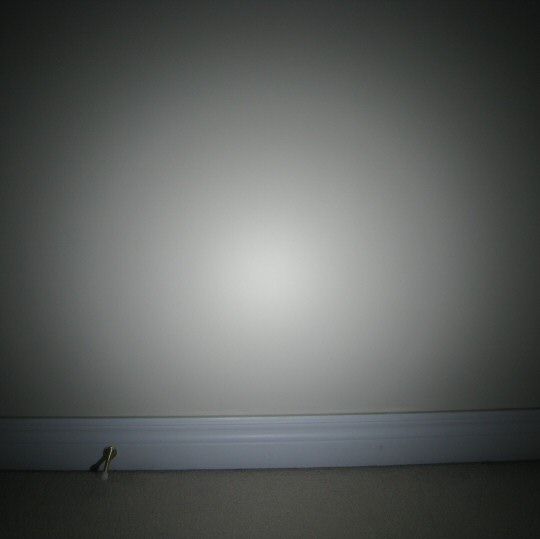
With RGB kit:
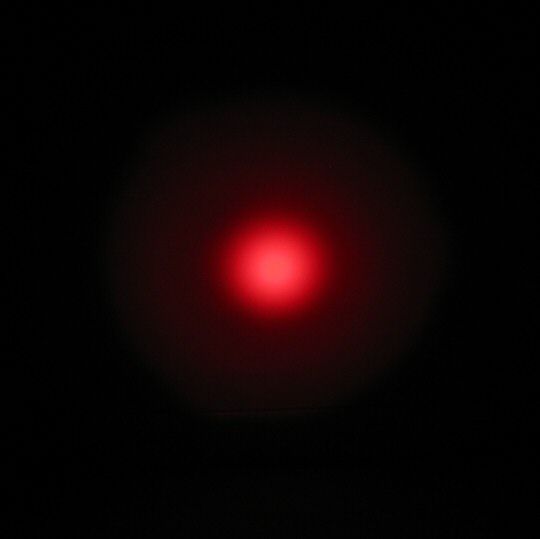
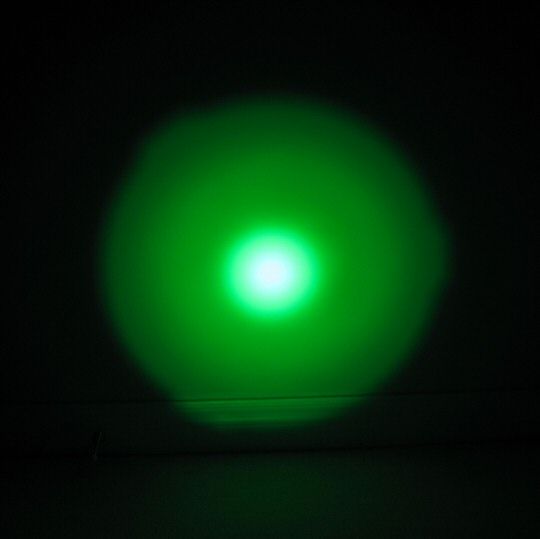
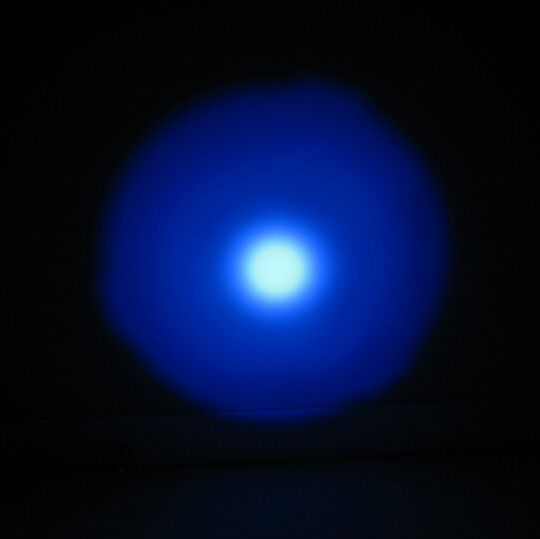
Not surprisingly, the red filter seems to allow the least amount of light through (white LEDs are well known to be somewhat deficient in the red wavelengths).
Here's a few more shots, taken up-close on my infamous "integrating carpet" :laughing:
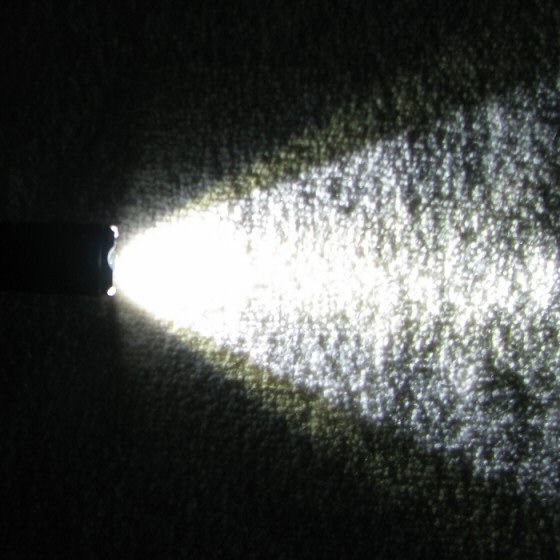
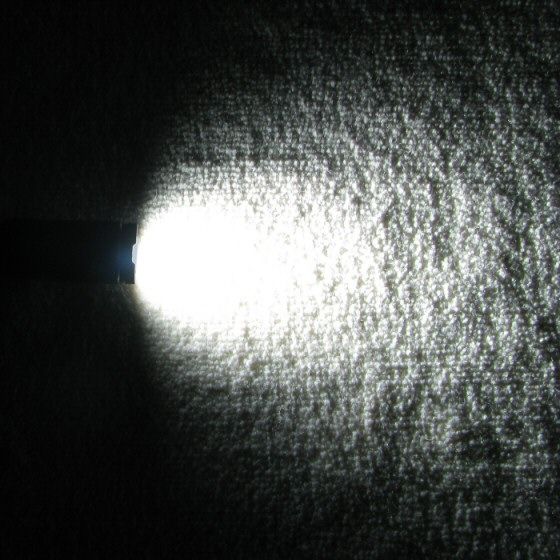
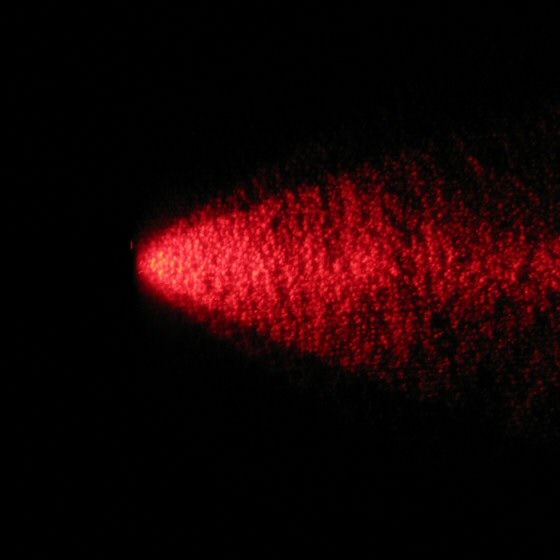
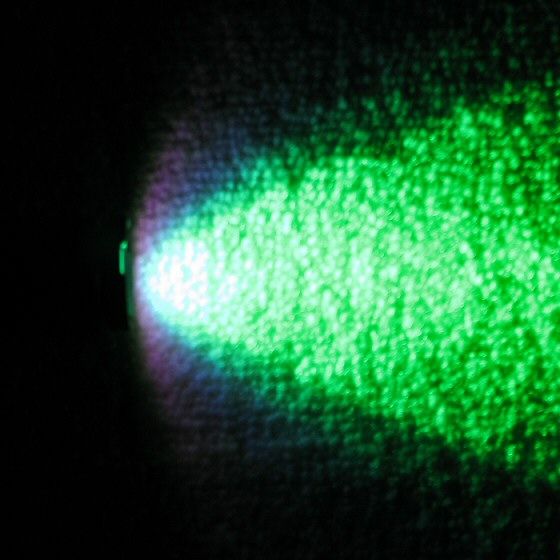
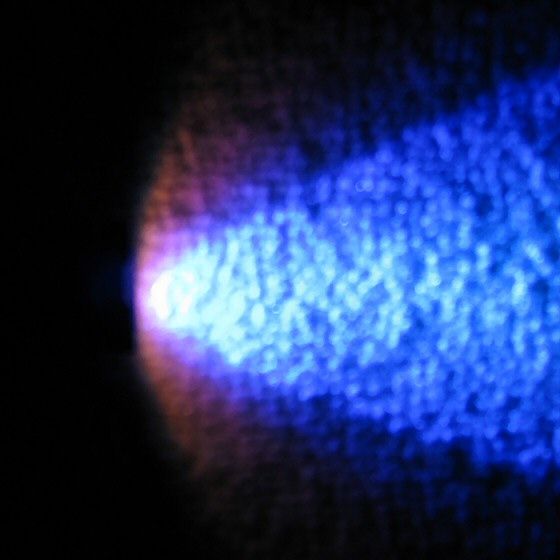
User Interface
The P20A2/C2 have the same interface as the T20C2 reviewed previously. Simply activate the light with the forward clicky (press for momentary, click for lock-on) - tighten the head for Turbo, loosen for General mode. :kiss:
There is a "hidden" low output mode that can be accessed by rapidly switching to or from Turbo/General within a sec or so (i.e. a rapid Turbo-General-Turbo, or General-Turbo-General switch). The low setting is not retained if you turn the light off – it will come back on in Turbo or General mode, depending on how you left the head. Interestingly, the light doesn't just jump from one output mode to another – when going down in output, it rapidly ramps down instead.
The other (unfortunately not-so hidden) mode is strobe – it is accessed by simply clicking off-on within 3 secs. :sigh: This removes the ability to rapidly signal in momentary mode, and means you will always strobe yourself if you turn the light back on within 3 seconds of it turning off. I would have preferred if strobe had been confined solely to a head switch instead of a simple off-on tail click. Note that the next batch of lights is supposed to have this delay reduced to 1sec.
Strobe frequency was measured at 8Hz, similar to the T20C2 and EagleTac M2-series lights.
No PWM (Pulse-Width-Modulation)
Consistent with other EagleTac lights, I was unable to detect any signs of PWM. As the runtimes clearly indicate, lower output levels appear to be current-controlled.
As the runtimes clearly indicate, lower output levels appear to be current-controlled.
Testing Method: All my output numbers are relative for my home-made light box setup, a la Quickbeam's flashlightreviews.com method. You can directly compare all my relative output values from different reviews - i.e. an output value of "10" in one graph is the same as "10" in another. All runtimes are done under a cooling fan, except for the extended run Lo/Min modes (i.e. >12 hours) which are done without cooling.
Throw values are the square-root of lux measurements taken at 1 meter from the lens, using a light meter.
Throw/Output Summary Chart:
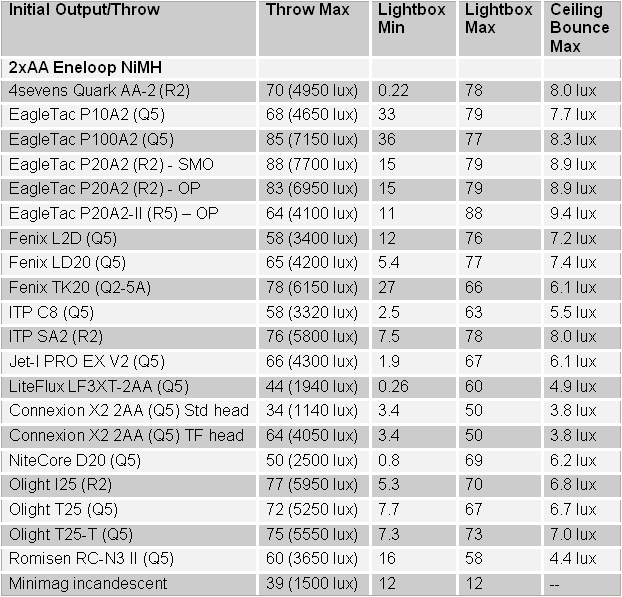
An interesting note here – my lightbox reports there isn't much difference between the various 2xAA EagleTac offerings (scroll down to runtimes for more info). However, by ceiling bounce, the P20A2 definitely leads the pack. I suspect this may have something to do with how the beam pattern and tint are interpreted by the lightbox, but it's hard to say for certain. By eye, the P20A2 does seem marginally brighter (scroll back to the beamshots).
Throw of the P20A2 is among the best of this class and size.
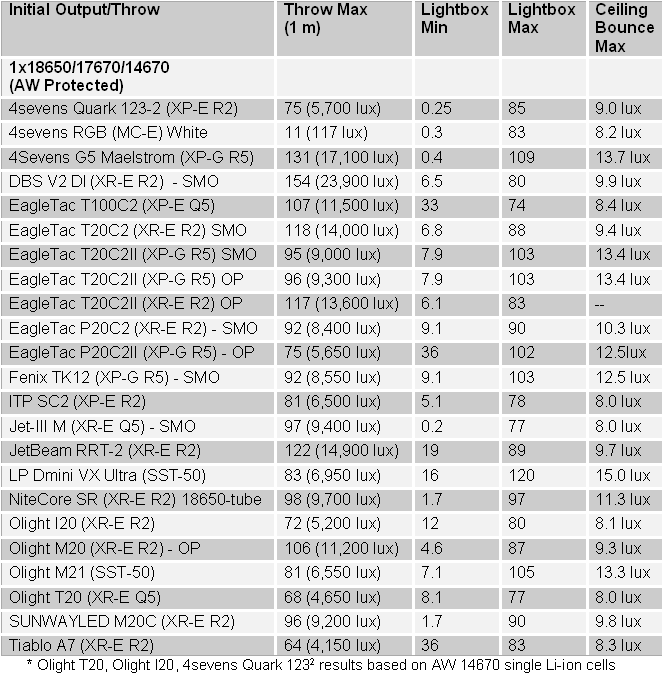
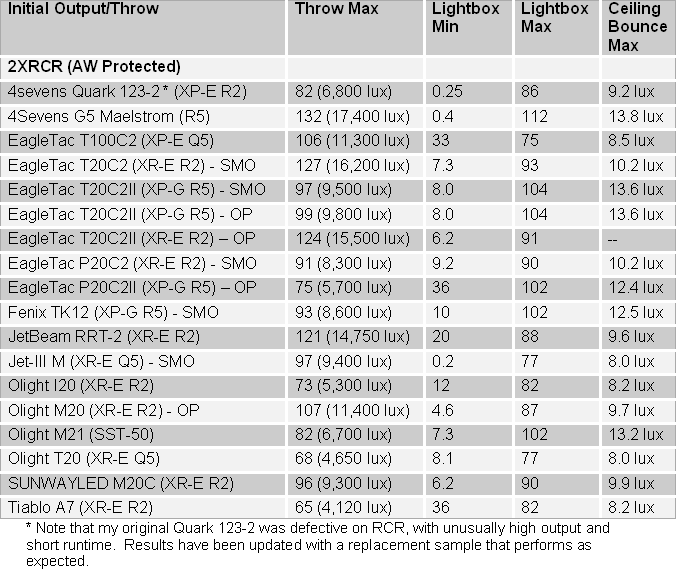
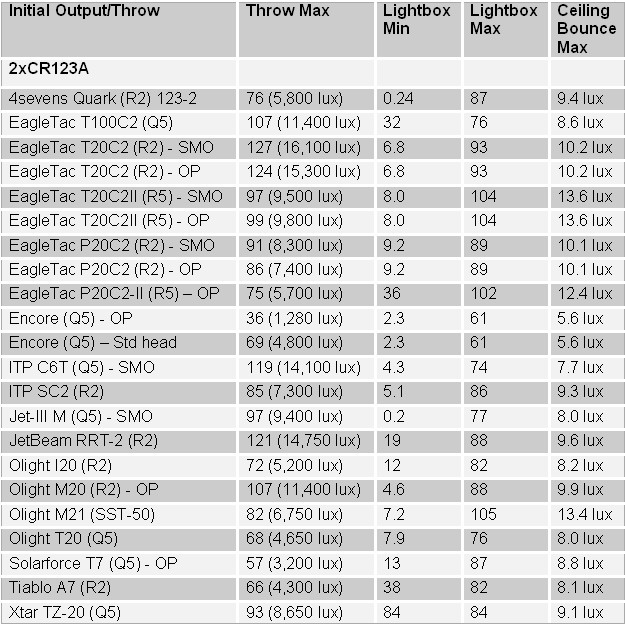
Interestingly, on 1xLi-ion, the P20C2 is a bit brighter than either of the other two recent EagleTac lights in this space – the T100C2 MII or the premium T20C2! oo: On RCR/CR123A, the T20C2 and P20C2 are actually pretty close in output, althought the T20C2 seems to have the edge.
oo: On RCR/CR123A, the T20C2 and P20C2 are actually pretty close in output, althought the T20C2 seems to have the edge.
As expected, throw is reduced on the P20C2 compared to the T20C2 and T100C2, due to the smaller head.
Output/Runtime Comparison:
P20A2
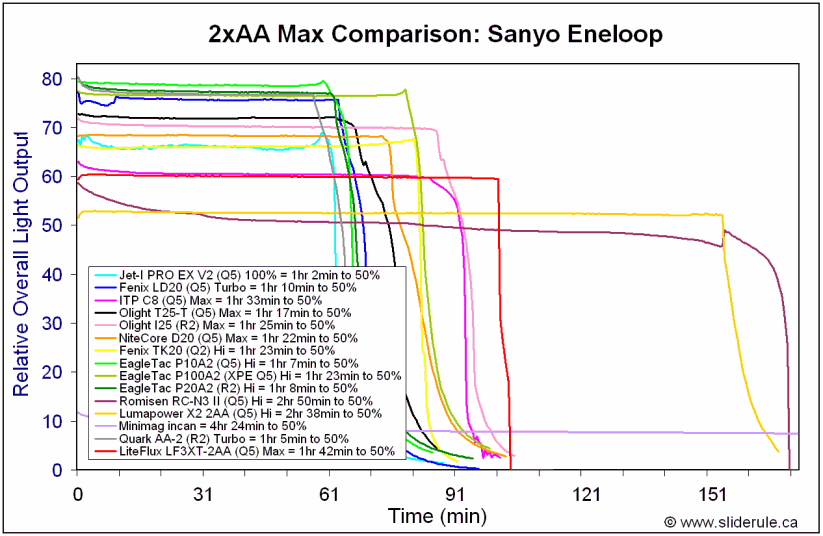
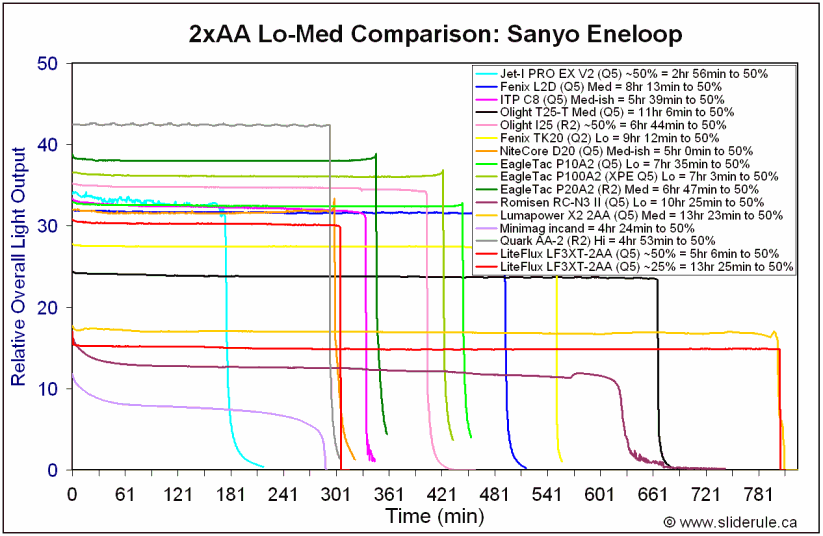
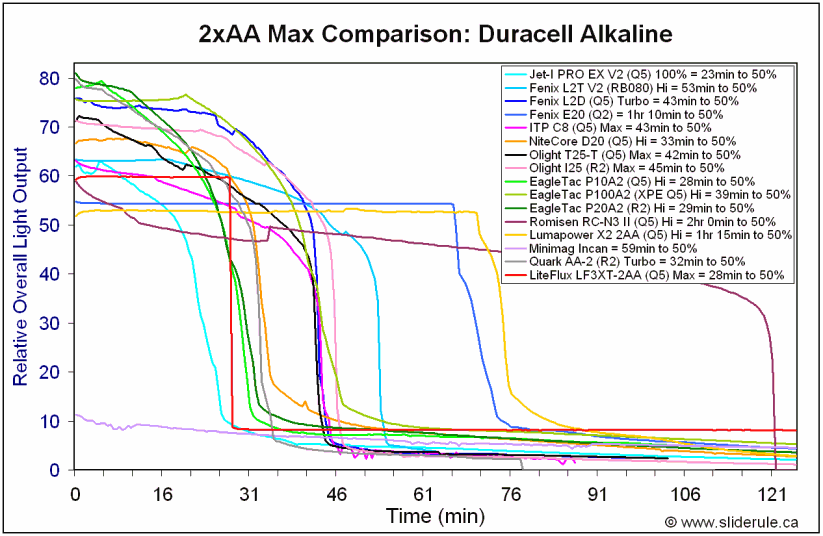
I've only done the basic runtimes on the P20A2, but you can see performance is right about where you would expect it - based on the older 2xAA EagleTac lights. Basically, they aren't so different from each other in terms of output/runtime. Note that although my lightbox shows the P10A2 is brighter over most of the run, by eye I would say that the P20A2 has a slight advantage. The difference isn't huge, though.
The output/runtime efficiency of P20A2's General/Turbo modes are also remarkably similar to the Quark QAA-2 Hi/Turbo. :thumbsup: I haven't done the Lo mode runtimes, but I suspect this relationship would hold up.
P20C2
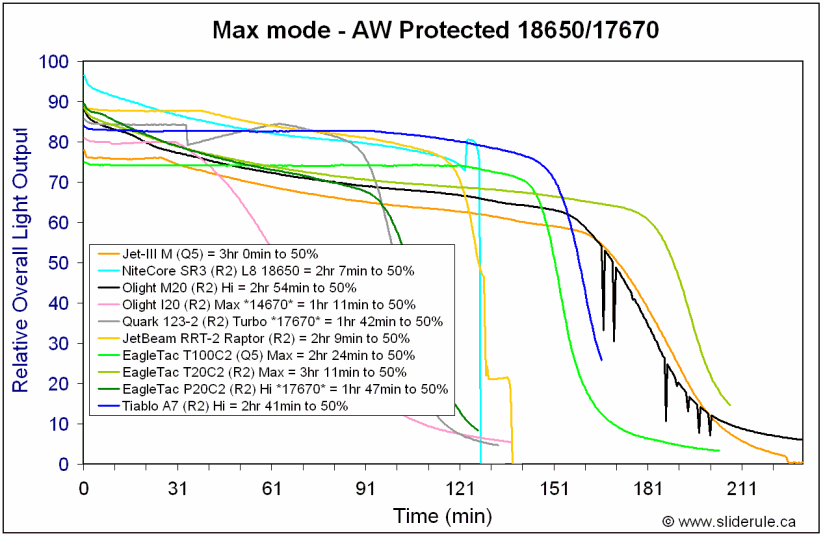
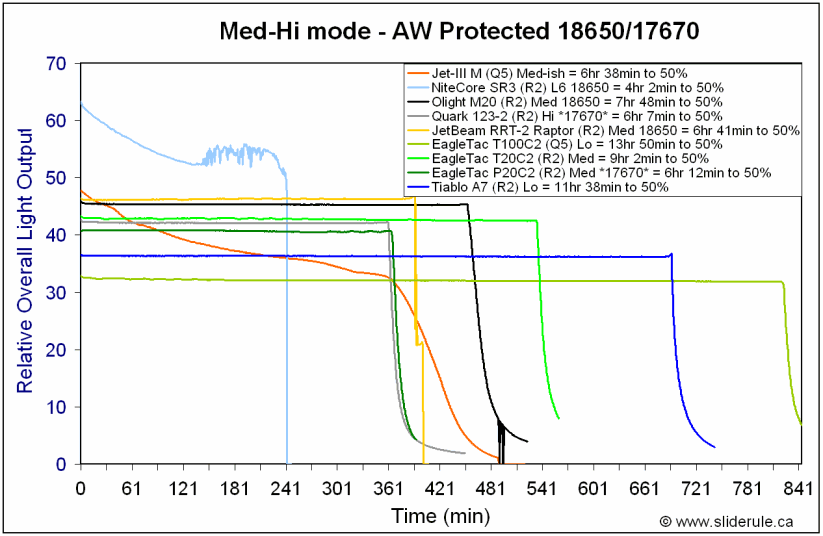
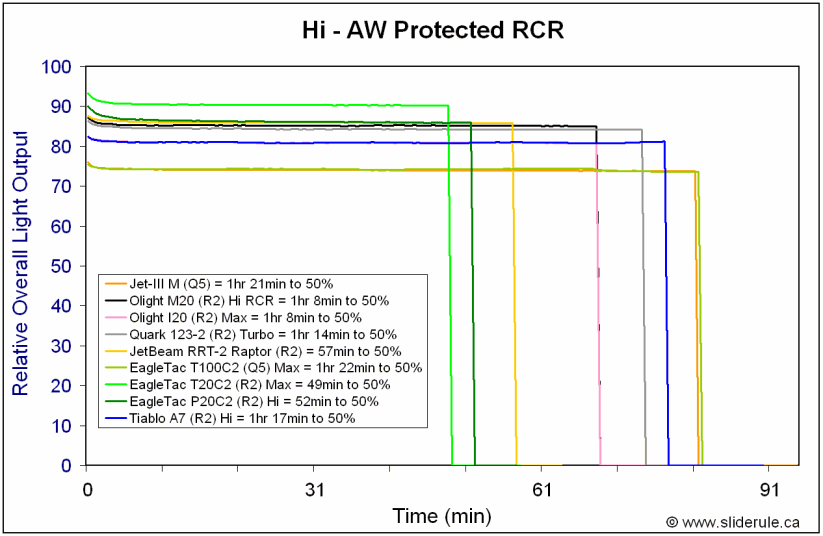
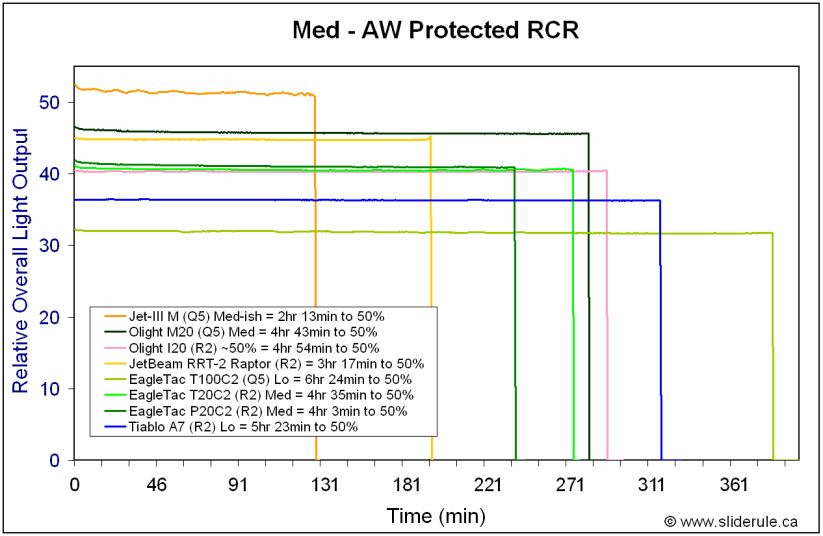
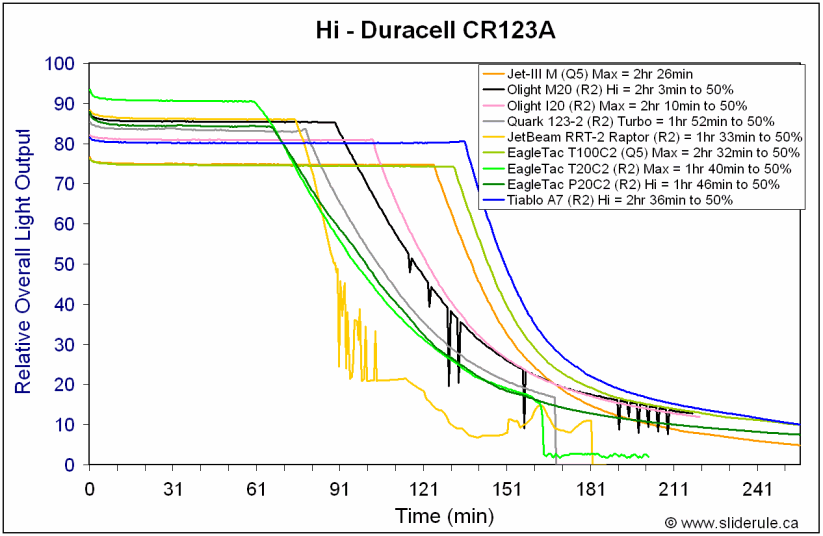
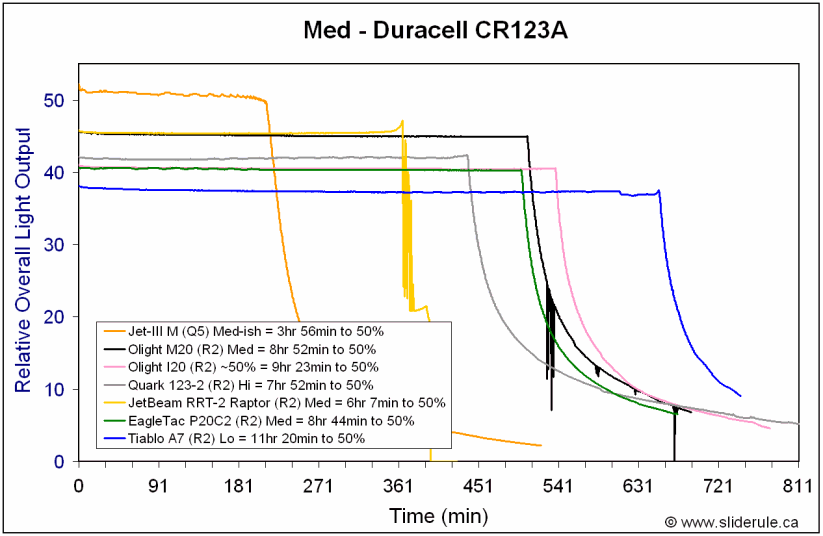
I've done a greater range of tests on the P20C2 (although still haven't done the Lo mode runtimes). So far, the conclusion is much the same as above – the output/runtime performance of the P20C2 is very similar to the T20C2 and the Quark Q123-2 (when you take into account the 17670 vs 18650 single Li-ion source). The T20C2 still has a max output advantage on CR123A/RCR, though.
The Q123-2 seems to have a runtime advantage over the EagleTac lights on Turbo on 2xRCR – but that could be a problem with my cells on the more recent EagleTac tests. :shrug: I will investigate further and report back.
Potential Issues
As with the T20C2, strobe mode is easily (and potentially inadvertently) accessed by clicking off and back on within 3 seconds on both the P20A2 and P20C2. Note that this is supposed to be reduced to 1sec in the next batch of lights.
Like most multi-power lights, the P20C2 is direct-drive on Max on 18650.
General Observations
EagleTac has taken the basic P10A2/C2 line and given them a make-over with the feature set and extras developed for the higher-end T20C2. Build-wise, the appearance is something of a hybrid between the old P10-series models and the new T20C2 styling. Fans of aggressive knurling will be happy – there's little risk of dropping these puppies!
Personally, I quite like the flexibility of these new builds – you get the good quality diffuser included in the basic package, and can customize your choice of reflector, tailcap, and RGB kit. :thumbsup:
Of course, you also get the new UI from the T20C2 – including the extra Lo mode and the easily accessible strobe mode. :sigh: Like many here, I don't like the loss of momentary signaling by having the strobe in the tailcap sequence. Frankly, this is one "innovation" of the T20C2 that I wish had not been ported over the P20 series. Note that this is expected to be revised on the next batch of all models by shortening the delay to 1 sec from 3 secs. While definitely an improvement, I would prefer to see it gone from the tailcap sequence altogether.
Circuit-wise, not much has changed to EagleTac's efficient multi-power circuits, although there does seem have been some tweaking of max output (plus the extra low mode). More of an incremental improvement here - EagleTac's performance remains up there with other current-controlled lights (e.g. Fenix, Quark, etc.).
At the end of the day, I think this is an overall positive upgrade to the line. The basic models P100A2/C2 are still available for those who want a pared-down interface and build (and lower cost). But the new P20A2/C2 basically help close the gap to the Tactical series lights.
UPDATE APRIL 21, 2010: EagleTac has come out with new Mark II versions of these lights. Please see my more recent review for details.
UPDATE APRIL 21, 2010: EagleTac has come out with new Mark II versions of these lights. Please see my more recent review for details.
Warning: Even more pic heavy than usual!
Manufacturer's specifications, condensed from EagleTac's website:
- Cree XR-E R2 LED (Cool White, WD tint) or Q4 (5A tint, Neutral White)
- P20A2 Maximum 230 lumen / 60lumen / 15lumen, Runtime 1.5 hrs / 8hrs / 55 hrs
- P20C2 Maximum 300 lumen / 60lumen / 5lumen, Runtime 1.5 hrs / 13hrs / 180+ hrs
- Three levels output, activate by twisting bezel
- Tactical strobe mode, operated by pressing rear switch
- Stainless steel crenelated bezel
- Syntax ultra-clear glass lens w/ hardening and AR coating
- Type III finish / aerospace grade aluminum
- Smooth aluminum reflector
- Gold plated on all contacts
- Agressive tactical knurling and griping aerodynamic
- Protruding tactical forward clicky tail-cap
- Base Model: ET-21 Diffuser Filter, Spare O-rings, GITD Switch Boot, Black Stainless Steel Pocket Clip, Heavy Duty Nylon Holster w/ Flip, User Manual
- RGB Kit Includes everything in base model, plus: ET-21 Red Filter (PP-RF1), ET-21 Blue Filter (PP-BF1), ET-21 Green Filter (PP-GF1). Chooice between smooth and OP reflector, choice between Cool White or Neutral White Emitter, choice between standard protruding tailcap or tail-standing tailcap (tail-standing includes paracord lanyard).
- Optional Accessories: Optional upgrade to orange peel reflector, optional tail-stand tail-cap. Weapon mount support
- P20A2 Length 6.3 inches (16.2 cm), Head Diameter: 1" (2.6 cm), Body Diameter: 0.8" (2.1 cm), Weight 3.2 ounces (91 grams)
- P20C2 Length 5.1" (13cm), Head Diameter: 1" (2.6 cm), Body Diameter: 0.8" (2.1 cm), Weight 2.8 ounces (79 grams)
- P20A2 Batteries: Two AA batteries (also compatible with NiMH rechargeables or 1.5V lithiums)
- P20C2 Batteries: Two Lithium CR123A batteries (also compatible with two Li-ion rechargeables)
- P20A2 MSRP $70 ($80 with RGB filter kit)
- P20C2 MSRP $75 ($85 with RGB filer kit)


By default, each P20A2/C2 comes with a manual, warranty card, spare o-rings, o-ring lube, extra GITD tailcap boot cover, good quality belt pouch with closing flap and lens diffuser attachment. :sweat: Optional accessories are the RGB filter kit (shown above), OP reflector, wrist lanyard and tailstanding tailcap (shown below).

Note that the green and blue filters have a reflective finish, just like the Olight filters. Here they are without and with a flash, to show you how they look:



From left to right: Duracell AA battery, EagleTac P20A2, P10A2, P100A2, Quark QAA-2.

From left to right: AW protected RCR, EagleTac P20C2, T100C2 MII, T20C2; Quark Q123-2.
P20A2: Weight 91.2g, Length 164mm, Width 26.6mm (bezel), 23.1mm (tailcap)
P20C2: Weight 78.8g, Length 133mm, Width 26.6mm (bezel), 23.1mm (tailcap)






The body tubes are the most obvious change from earlier lights. Consistent with the new T20C2, there are now extra raised areas along the length. Given the lower thickness of these lights, this looks a little cheesy to me – but that's just a personal preference
 Note that the body tube of the P20C2 is only wide enough to allow a protected 17670 cell to fit – 18650 is too wide.
Note that the body tube of the P20C2 is only wide enough to allow a protected 17670 cell to fit – 18650 is too wide.Fit and finish are excellent on my sample, no obvious flaws in the black type-III hard anodizing (although chips in the knurling are not uncommon on EagleTac lights). Consistent with other EagleTac lights, the knurling on the bezel and tailcap is quite aggressive. Identification labels are very sharp and clear, in bright white against the black background.




Screw threads are anodized for head or tailcap lock-out. :thumbsup: Due to the standard protruding forward clicky, the light cannot tailstand in its default form – but you can get the tailstanding tailcap accessory (scroll back up for a pic).
Note that the black stainless steel clip is removable, but be careful not to scratch the anodizing when removing/attaching the clip (I find a little teflon oil can help).

The reflector can be easily swapped after unscrewing the head portion of the light. To allow you to better compare, I've installed the OP reflector in the P20C2 for the shots below.




The light uses the standard Cree XR-E emitter, with a R2 output bin in this case (WD tint reported). Also available from EagleTac is the relatively warm "neutral" 5A tint with a Q4 output bin. For those of you not familiar with tint bins, please see my Colour tint comparison and the summary LED tint charts found here.
And now for the requisite white wall shots: all lights are on Max on an Sanyo eneloop (2xAA lights) or AW protected 18650/17670, about 0.5 meters from a white wall.
First, a direct comparison of the P20A2 (with smooth reflector) and P20C2 (with OP reflector):




As you can see, there is not a huge difference in terms of the beam profile. I personally prefer the OP reflector, as it helps smooth some of the rings without affecting throw very much (reminds me of the early JetBeam Jet-II/III reflectors - some smoothing, with little loss of throw).
Here's how the lights compare to some of the competition:
P20A2



P20C2



One of the more interesting features of these lights is how you can remove the bezel retaining ring and screw on the included diffuser (or optional RGB filter kit). This is a fairly smart way to attach a filter/diffuser, although you have find a place to stick the bezel ring when not in use. I found mine all screwed on fairly easily (except for the red filer in one case, which was a little stiff). The quality of the included filters and diffuser seem very good – on par with the Olight filter/diffuser material available for a number of their lines.
To help you compare the effects of the diffuser and RGB filters, here are some individual shots taken of the P20C2 with the OP reflector (~1m from the wall, 1/25sec exposure, f3.2).
OP reflector:

With diffuser:

With RGB kit:



Not surprisingly, the red filter seems to allow the least amount of light through (white LEDs are well known to be somewhat deficient in the red wavelengths).
Here's a few more shots, taken up-close on my infamous "integrating carpet" :laughing:





User Interface
The P20A2/C2 have the same interface as the T20C2 reviewed previously. Simply activate the light with the forward clicky (press for momentary, click for lock-on) - tighten the head for Turbo, loosen for General mode. :kiss:
There is a "hidden" low output mode that can be accessed by rapidly switching to or from Turbo/General within a sec or so (i.e. a rapid Turbo-General-Turbo, or General-Turbo-General switch). The low setting is not retained if you turn the light off – it will come back on in Turbo or General mode, depending on how you left the head. Interestingly, the light doesn't just jump from one output mode to another – when going down in output, it rapidly ramps down instead.
The other (unfortunately not-so hidden) mode is strobe – it is accessed by simply clicking off-on within 3 secs. :sigh: This removes the ability to rapidly signal in momentary mode, and means you will always strobe yourself if you turn the light back on within 3 seconds of it turning off. I would have preferred if strobe had been confined solely to a head switch instead of a simple off-on tail click. Note that the next batch of lights is supposed to have this delay reduced to 1sec.
Strobe frequency was measured at 8Hz, similar to the T20C2 and EagleTac M2-series lights.
No PWM (Pulse-Width-Modulation)
Consistent with other EagleTac lights, I was unable to detect any signs of PWM.
Testing Method: All my output numbers are relative for my home-made light box setup, a la Quickbeam's flashlightreviews.com method. You can directly compare all my relative output values from different reviews - i.e. an output value of "10" in one graph is the same as "10" in another. All runtimes are done under a cooling fan, except for the extended run Lo/Min modes (i.e. >12 hours) which are done without cooling.
Throw values are the square-root of lux measurements taken at 1 meter from the lens, using a light meter.
Throw/Output Summary Chart:

An interesting note here – my lightbox reports there isn't much difference between the various 2xAA EagleTac offerings (scroll down to runtimes for more info). However, by ceiling bounce, the P20A2 definitely leads the pack. I suspect this may have something to do with how the beam pattern and tint are interpreted by the lightbox, but it's hard to say for certain. By eye, the P20A2 does seem marginally brighter (scroll back to the beamshots).
Throw of the P20A2 is among the best of this class and size.



Interestingly, on 1xLi-ion, the P20C2 is a bit brighter than either of the other two recent EagleTac lights in this space – the T100C2 MII or the premium T20C2!
As expected, throw is reduced on the P20C2 compared to the T20C2 and T100C2, due to the smaller head.
Output/Runtime Comparison:
P20A2



I've only done the basic runtimes on the P20A2, but you can see performance is right about where you would expect it - based on the older 2xAA EagleTac lights. Basically, they aren't so different from each other in terms of output/runtime. Note that although my lightbox shows the P10A2 is brighter over most of the run, by eye I would say that the P20A2 has a slight advantage. The difference isn't huge, though.
The output/runtime efficiency of P20A2's General/Turbo modes are also remarkably similar to the Quark QAA-2 Hi/Turbo. :thumbsup: I haven't done the Lo mode runtimes, but I suspect this relationship would hold up.
P20C2






I've done a greater range of tests on the P20C2 (although still haven't done the Lo mode runtimes). So far, the conclusion is much the same as above – the output/runtime performance of the P20C2 is very similar to the T20C2 and the Quark Q123-2 (when you take into account the 17670 vs 18650 single Li-ion source). The T20C2 still has a max output advantage on CR123A/RCR, though.
The Q123-2 seems to have a runtime advantage over the EagleTac lights on Turbo on 2xRCR – but that could be a problem with my cells on the more recent EagleTac tests. :shrug: I will investigate further and report back.
Potential Issues
As with the T20C2, strobe mode is easily (and potentially inadvertently) accessed by clicking off and back on within 3 seconds on both the P20A2 and P20C2. Note that this is supposed to be reduced to 1sec in the next batch of lights.
Like most multi-power lights, the P20C2 is direct-drive on Max on 18650.
General Observations
EagleTac has taken the basic P10A2/C2 line and given them a make-over with the feature set and extras developed for the higher-end T20C2. Build-wise, the appearance is something of a hybrid between the old P10-series models and the new T20C2 styling. Fans of aggressive knurling will be happy – there's little risk of dropping these puppies!
Personally, I quite like the flexibility of these new builds – you get the good quality diffuser included in the basic package, and can customize your choice of reflector, tailcap, and RGB kit. :thumbsup:
Of course, you also get the new UI from the T20C2 – including the extra Lo mode and the easily accessible strobe mode. :sigh: Like many here, I don't like the loss of momentary signaling by having the strobe in the tailcap sequence. Frankly, this is one "innovation" of the T20C2 that I wish had not been ported over the P20 series. Note that this is expected to be revised on the next batch of all models by shortening the delay to 1 sec from 3 secs. While definitely an improvement, I would prefer to see it gone from the tailcap sequence altogether.
Circuit-wise, not much has changed to EagleTac's efficient multi-power circuits, although there does seem have been some tweaking of max output (plus the extra low mode). More of an incremental improvement here - EagleTac's performance remains up there with other current-controlled lights (e.g. Fenix, Quark, etc.).
At the end of the day, I think this is an overall positive upgrade to the line. The basic models P100A2/C2 are still available for those who want a pared-down interface and build (and lower cost). But the new P20A2/C2 basically help close the gap to the Tactical series lights.
UPDATE APRIL 21, 2010: EagleTac has come out with new Mark II versions of these lights. Please see my more recent review for details.
Last edited:


 I gotta get one of those..
I gotta get one of those..